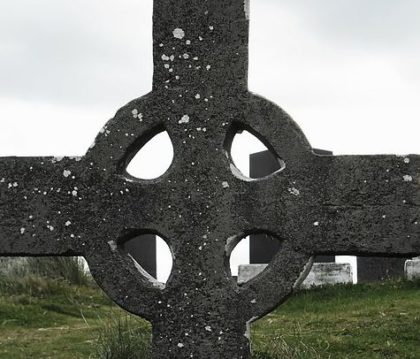Tammie Grimm ~ The Celtic Cross

With its distinctive orb that surrounds the intersecting arms that form the right angles of the Latin cross, most of us recognize the shape and design of the traditional Celtic cross. No matter our level of familiarity with the prayers, traditions and other customs of the medieval Celtic Christians, the iconic artwork of the cross is no ancient relic relegated to history. Numerous high standing crosses of stone that first began to dot the landscape of the British Isles in the 4th and 5th century still remain. But today the Celtic cross is more likely to be worn as jewelry or tattoo art than to be constructed as a visible landmark for all in the vicinity to guide their steps and judge their distance from one place to another.
 As popular and distinctive as it might be, the origins of the Celtic cross are not necessarily exclusively Celtic. The ring that gives the cross its distinctive flair might have been first used as arches designed to support or stabilize intersecting beams. There are some who claim that, rather than a crucifix, the Celtic cross depicts a crown resting on the cross on which the prince of glory died. Or, as legend has it, it might have been a pagan symbol for the moon goddess that St. Patrick superimposed with a Latin cross, thus uniting two symbols that allowed him to evangelize more effectively. Regardless of how it came to be, the meanings inherent in the symbolism of Celtic crosses are almost as varied as the numerous knot-works and patterns that often emboss them.
As popular and distinctive as it might be, the origins of the Celtic cross are not necessarily exclusively Celtic. The ring that gives the cross its distinctive flair might have been first used as arches designed to support or stabilize intersecting beams. There are some who claim that, rather than a crucifix, the Celtic cross depicts a crown resting on the cross on which the prince of glory died. Or, as legend has it, it might have been a pagan symbol for the moon goddess that St. Patrick superimposed with a Latin cross, thus uniting two symbols that allowed him to evangelize more effectively. Regardless of how it came to be, the meanings inherent in the symbolism of Celtic crosses are almost as varied as the numerous knot-works and patterns that often emboss them.
For some, the circle symbolizes eternity, whether it be attributed to God, God’s love or the mystery of God. Others believe the circle highlights the eternal mystery of how the crucifixion and resurrection are united together, or the endless nature of Christ’s sacrifice upon the cross. Some even believe the circle represents the world and its creation that is merged with the crucifixion of Christ, thus merging the two into one symbol that represents life, hope and resurrection.
While some Celtic crosses are plain without any inscribed artwork, many Celtic crosses are adorned with elaborate knot work that is typically raised from the stone, metal or wood from which the cross is made. Gemstones or contrasting metals might be used in jewelry as well. Celtic knot work has always been a mainstay of the cross, though many medieval high crosses depict stories of the Christian faith. The artwork can be as plain or as simple as a Triquetra (the three interwoven leaves representing the Trinity) or a much more intricate weaving that mesmerizes in its seemingly endless complexity. Still, the design never meanders aimlessly or so convoluted that it jumbles and snarls. Always, the Celtic knots and strands twist and braid a pattern that is beautiful and elegant, at once demonstrating the complexity of God’s creativity and the simplicity or unity that marks all things as God’s creation.
For believers of any time or generation, the Celtic cross is a beloved symbol that captures our imagination and evokes the mystery and love that lies at the heart of the Christian faith. And after all, that is as it should be, for what is Christianity without the cross?
May the cross of the crucifixion tree
Upon the wounded back of Christ
Deliver me from distress,
From death and from spells.
The cross of Christ without fault,
All outstretched towards me;
O God, bless to me my lot.
Before my going out.
What harm soever may be therein
May I not take thence,
For the sake of Christ the guileless,
For the sake of the King of power.
In the name of the King of life,
In the name of the Christ of love,
In the name of the Holy Spirit,
The Triune of my strength.